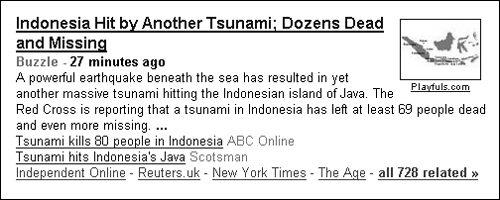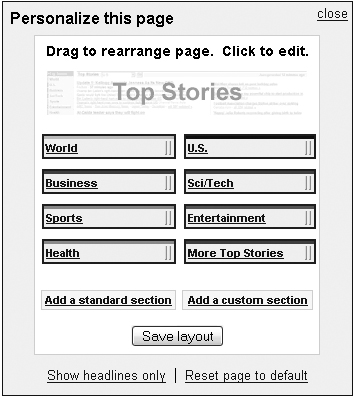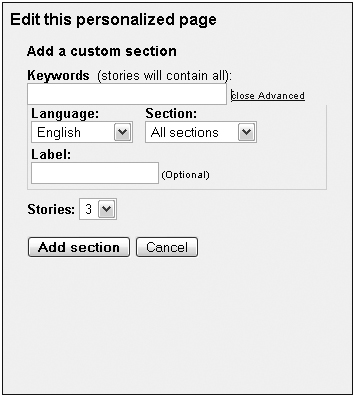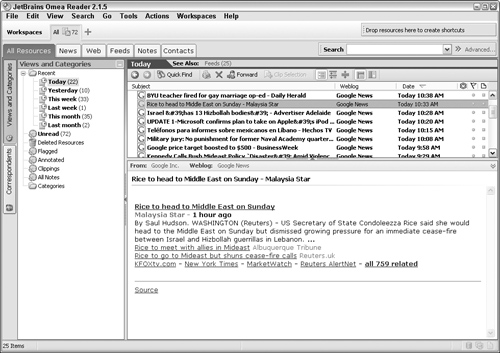Find your way through the news
Read the news in your own language
Search through Google News
Personalize the Google News page
Set up a Google News Feed
Stay up to date with Google Alerts
Manage Google Alerts
Google is a news service of a different sort. Technically, Google is a news aggregator. Rather than having its own reporters and gathering its own news, Google searches through the news of 4,500 other news sources and presents the best of the news to you in a form that feels like other news pages.
Point your Web browser to http://news.google.com to begin viewing Google News. You can also navigate to the news page by clicking the News link on the Google search page. As mentioned earlier, Google News is an aggregator of news. This means that Google gathers news articles from different news sources and redisplays it. Not all the articles from all 4,500 news sources are displayed. When you first launch the Google News Web site you are shown the Standard News version. This version displays the top news stories from around the world. This page is automatically generated on a regular basis. You can even see how long it has been since the page was auto-generated by looking in the top-right corner of the News page, where the length of time since the last page was generated appears.
A short abstract of each news story appears with its title as a clickable hyperlink. In addition to the story brief, links to additional related stories appear beneath the abstract. Usually, the first two are links to stories and other news sources carrying a related story.
Note
Clicking the links to related news sources will cause you to navigate away from Google News. To return to the Google News page, click the Back button in your browser.
View the full story by clicking either the title of the story or the small thumbnail image that appears with each story, as shown in Figure 14.1.
Each section of Google News can be accessed using the menu along the left side of the Google News page. By default, when you first load Google News, the Top Stories menu selection is highlighted. Clicking the various menu choices reloads the page with the new selected news stories. Your choices are:
Top Stories: Main news stories of the moment
World: Top stories from many countries around the world
[Country]: Menu selection changes based on the country you select (see News in Your Language)
Business: Top business and economic stories of the day
Sci/Tech: Top science and technology stories
Sports: Stories about athletes, games, and sports contests
Entertainment: News about movies, television, live productions, and performers
Health: Top advances in medicine, drug therapies, treatments, and world health stories
Most Popular: Displays the stories most selected by other readers in order from most read to least read
The menu appears while viewing any of the Google News pages. Also in the left menu are links to news alerts, news feeds, and mobile news, which are covered later in this chapter.
The Top Stories of the moment appear at the top of the Google News page. These stories can change as Google news auto-generates new pages. Normally, just a couple of articles are displayed in the Top Stories section. You will notice that next to the Top Stories title there is a drop-down list of countries. Changing countries often changes the language in which Google News is displayed (see News in Your Language later in this chapter).
Tip
Try clicking the Refresh button in your Web browser to see if the Top Stories change. Quite often different stories will be displayed.
Remember that clicking a link to view a full story causes your browser to navigate away from Google News. To return, click your browser’s Back button. It normally appears in your browser’s menu bar as a left arrow.
By default, abstracts from the top 20 World news, Sports, U.S. (or the country you have configured), Business, Sci/Tech, Entertainment, Health, and the Most Popular stories are displayed. You can scroll down the page viewing each of the brief stories. Just like the main Google News page, each story lists the source of the story and links to related news stories. The Most Popular stories are rated by the number of people who have clicked on the abstracts to open the full text of the articles.
Each section is configurable so that you can choose to see more or fewer stories in that section. At the end of each section there are links, Show more stories, and Show fewer stories. Click these links to view Google News the way you want to see it.
Select the country you want to view from the Top Stories drop-down list along the top of the Google News page. Selecting a new country displays headlines associated with the country you select. The world headlines often change with the country setting but may remain the same.
When selecting a new country, the language most associated with that country is used to display the Web page. In countries like India that have multiple languages but where English is the dominant language, news articles are displayed in English.
When using Internet Explorer, Google automatically senses the language your browser has set as the default language and shows you the news for that area of the world. Not only are the news articles displayed in the language you have set in your browser, Google displays different news articles that it believes will interest you based on the language you speak.
To change the language set in your Internet Explorer Web browser, follow these steps:
From the menu, choose Tools
 Internet Options.
Internet Options.In the Internet Options dialog box, click Languages, which is located along the bottom of the dialog box.
If the language you want to use is not displayed, click Add. Select a language and click OK.
When the language you want to use is listed, or you added it in step 3, click once on the language to highlight it (see Figure 14.2).
Click Move Up until the language you want to use is at the top of the list.
Click OK once in the Language Preference dialog box and again in the Internet Options dialog box to complete the language change.
Caution
Changing the default language changes the language for all Web pages you visit. Some Web pages are only accessible by people viewing in a particular language. For example, America Online’s www.aim.com can only be viewed using the U.S. English language. Viewers using other languages are redirected.
Google does not sense the Firefox browser language setting. You can refer to the Firefox help for more information about setting the default language settings. The steps are similar to Internet Explorer except you find the language settings among the Advanced option settings.
At the bottom of each Google News page is a list of the different international versions of Google News. You can select an international version by clicking the link associated with the name of the country, and news is displayed in the primary language of that country.
On the right side of the Google News page you will find a Personalize this page link, which when clicked, reloads the page with a Google News configuration page.
There are a couple of browser settings that need to be correctly configured before you can configure and personalize Google News.
First, you must have JavaScript enabled in your Web browser. JavaScript is the scripting language that Google uses to allow editing of the configuration. The following sections provide instructions for enabling or making certain that JavaScript is already enabled in your Web browser. If you use a Web browser other than Internet Explorer or Firefox refer to the Web browser Help for instructions on enabling JavaScript.
Procedure 14.1. STEPS: Enabling JavaScript in Internet Explorer
From the Internet Explorer menu choose Tools
 Internet Options.
Internet Options.Click the Security tab in the Internet Options dialog box.
Click Custom Level. Scroll through the security settings until you find Scripting.
Under Active Scripting, select the Enable radio button.
Click Yes in the Warning message box.
Click OK in the Security window.
Procedure 14.2. STEPS: Enabling JavaScript in Firefox
From the Firefox menu, choose Tools
 Options.
Options.Click the Content tab.
Make certain the Enable JavaScript checkbox is checked; if not, click it to place a check in the box.
Click OK.
It is important to have cookies enabled in your Web browser to make it possible to save the personalized Google News configuration. Cookies are small files associated with a Web site where configuration information can be saved. Enabling cookies creates information security concerns. When enabling cookies you will need to manage them. Simply erasing cookies causes you to lose your Google personalization. Using an adware and spyware checker regularly to control which cookies are saved and which are deleted is a good idea.
Click and drag the various sections by the vertical bars on the right side of the button to reorder how they appear when you load Google News. As you drag the item to its new position, that area is highlighted. Releasing your mouse button after dragging the section to its new location repositions it. You can drag items up and down and between left and right columns. Once you arrange the sections to how you want them to appear you can further personalize each section.
At any time while customizing your Google News page, you may log in using your Google ID and save your configuration on the Google server, rather than only on your local computer. This enables you to view your customized version of Google News on any computer whenever you log in to Google on any computer.
Click on a section, such as World, in the Edit this personalized page box and you can select the edition you want to appear by choosing an edition from the drop-down list. You may also select the section by choosing from the second drop-down list. Further personalize the section by choosing how many stories you want to appear in that section. Finally, you can delete the section altogether.
Tip
You do not need to be logged in to Google News to personalize the News page. Log in to save your configuration for customized viewing on other computers.
You can save your configuration at any time by clicking Save layout. Once you save your configuration, a message displays letting you know that “You’ve created your own unique, personalized version of Google News on this computer.”
Add either additional standard, predefined sections to the Google News page or add your own custom section. Adding a standard section allows you to add back sections you might have previously deleted or create a new version of a section you have already chosen to display. The new standard section is created by first selecting the Edition; for example, if you are viewing the U.S. edition by default, perhaps you also want to see the world news from the United Kingdom. In this case you select U.K. from the edition and then select World from the Section drop-down list. You can also select how many stories you want to appear in that section.
Note
You are limited to the display of 20 sections. This includes the standard sections and any custom sections you create.
When you finish adding a standard section, click Add section. Your Google News page now appears as you’ve customized it, and the Personalize this page link now reads Edit this personalized page. To make further changes at any time click the Edit this personalized page link.
You can further enhance your Google News viewing by creating a custom section and adding it to Google News. Begin adding a custom section by clicking the Add a custom section link. The simplest way to create a custom section is to type one or more keywords, select the number of stories, and click Add section. Be aware that all of the keywords you type must appear in the stories, so adding too many keywords may result in no—or very few—stories appearing in your custom section.
Create custom sections using the advanced features to further personalize each section. Click the Advanced link next to the Keywords text box. The Advanced selections appear (see Figure 14.4). In addition to adding keywords, you can also select in which news sections those keywords appear. For example, when typing a name as a keyword and wanting only to see news articles about sports figures with that name, you can select Sport from the Section drop-down list.
The advanced features also allow you to select the language of your keywords. This limits stories to articles written in the language you select. Add a label for your new custom section by typing it in the Label: text box. If you do not type a label, Google creates a label based on the keywords you typed. You can then select the number of stories you want to appear or leave it at the default number of three. Click Add section to complete your configuration.
Tip
Remember that after you add new sections you can rearrange how they appear on your Google News page.
Click Save Layout if you have changed the layout of your sections. When you finish customizing your Google News page, click the Close link on the Edit personalized page box.
Each Google News article is displayed with the title, an abstract of the article, a list of the sources, and the time it was last updated. You can simplify browsing Google News by viewing only the headlines and eliminating the abstract of the article and the accompanying thumbnail. The headline of the article appears with the source of the news article and the time it was last updated. In the Edit this personalized page box click the Show headlines only link. To switch back to displaying the abstract and image click the Show images and text link.
Google News Feeds allow you to use third-party computer applications called news feed readers to further aggregate news and other Internet-based information sources. You normally use a news feed reader to view the news rather than viewing the news using your Web browser. Google provides news feeds in two XML formats: RSS and ATOM. XML (eXtended Markup Language) is a way of presenting information in a standardized form through the World Wide Web. A news feed reader must support either or both of these XML formats.
To use a news feed from Google News, first find and install a news feed reader. You can Google “news feed readers” for more information or simply download and install JetBrains Omea Reader. We have found this news feed reader to be simple, powerful, and free. This is the news feed reader we use for the instructions that follow. Other news feed readers operate in a similar manner.
Download the JetBrains Omea Reader from: www.jetbrains.com/omea/reader/.
Once you install the news feed reader you are ready to begin adding news feeds. To use the JetBrains Omea Reader to add a Google News feed, follow these steps:
Navigate to the Google News page or News search result.
Click on either the RSS or Atom link beneath the Google News menu on the left side of the page. This loads an XML page, which may appear cryptic to you.
Right-click in the JetBrains Omea Reader Feeds folder and select Subscribe to Feed... from the pop-up menu. The Subscribe to Feed dialog box appears.
In the “Enter the address of an RSS or ATOM feed” text box, the address of the Google News feed should have been automatically added (see Figure 14.5). If not, copy the address of the news feed page from the address bar of your Web browser and paste it in this text box.
Click Next. This returns you to the Subscribe to Feed dialog box.
You can choose to have all the feeds go into the same folder or create a new folder to better organize your news feeds. Click Next.
Your news feed automatically loads and news article titles appear in the top-right pane of the news feed reader (see Figure 14.6). To read the abstract, click once on the title and the abstract is loaded into the bottom pane. Clicking the title of the article in the lower pane loads the article just as it would load in a Web browser.
Quite often, the first thing a person looks at when he or she sits down at the computer is e-mail—not the day’s news, Google groups, or the Web for interesting content. E-mail alerts, once just for news, now allow you to receive notification of breaking news, items of interest added to Google Groups, or items found on the Web. The alert is delivered to you as an e-mail message. This allows business professionals to respond quickly to world events as they are happening or keep abreast of group discussion topics. In general, it allows you to keep up to date with an unlimited number of topics through the aggregated Google News, through the many Google discussion groups, and through Web pages.
On the Google News page (http://news.google.com), click the News Alerts link along the left side of the page. The link has a mail icon next to it. You can also access alerts directly by typing www.google.com/alerts into your Web browser. This launches the Google Alerts page shown in Figure 14.7. By filling in the form on this page you can create news alerts.
First, in the Search terms: text box type one or more keywords that Google can use to match in the news, groups, or the Web. Remember, the more words you type here, the more restrictive the search. You can get the most out of your searches by using the advanced search features of News, Google Groups, and Web searching. Visit the advanced search page in each of these areas and create an advanced search. Then paste it into the Alert Search Terms: text box.
The second step is to choose a source for your alert by choosing one from the Type: drop-down list. This sets the type of query that Google performs to see if it should send you an alert or not. This search is done automatically (see the next section). The types of searches are:
News: A Google News query that alerts you when there are new News articles that make it into the top ten results or your Google News search.
Web: Receive alerts when your Web query finds new Web pages in the top 20 results of your search.
News & Web: Get alerts when your query through the news is within the top ten results or when your search ends up in the top 20 Web search results.
Groups: This is a query through Google Groups. You will receive an alert if your search through new posts since your last search has hits within the top 50 results.
At this time there is no way to combine the search through Google Groups with the other searches. You can easily create a second alert on the same keywords and effectively accomplish the same thing.
Configure how often alerts are sent to you. You can choose to see results daily (only if there are results), immediately, and once a week. Select the frequency from the How often: drop-down list. The selections are:
once a day: Receive a single alert e-mail per day.
as-it-happens: Get breaking news stories or alerts when new Web pages or Google Group posts appear.
once a week: Saves the results and presents them all to you only once a week.
You can change the frequency or cancel your alerts at any time.
The last step in configuring your request is to type the e-mail address where you want your Google Alerts delivered. Remember, if you type an e-mail address different from the one you use for your Google account you cannot use your Google account to manage these alerts. They will need to be managed by canceling the alert from the e-mail alert sent to you.
When you finish typing your e-mail address and configuring your Google Alert, click Create Alert. This sends the Alert request to Google, which then sends a verification request to the e-mail address you typed when creating the Alert.
Once you submit your request, a notification that your request has been accepted and that a verification e-mail has been sent to you. You are not finished, however. You must respond to the e-mail verification or you will not receive e-mail alerts on the topic you submitted. In the e-mail shown in Figure 14.8 you see two possible links: one to confirm and verify the alert and one to cancel. Assuming that you click the link to confirm, a new Web page appears letting you know that the Google Alert was verified. Of course, if you choose to cancel, a Web page that lets you know your alert was canceled appears.
Alerts can be altered or canceled based on your changing needs. It is recommended that you sign up for and use your Google account when managing alerts. It is possible to manage alerts without an account, but it is just a little more complicated. To manage alerts without a Google account you must choose to cancel the alert by clicking the Cancel link in the alert e-mail you receive. Your only choice is to cancel the alert. Of course, you can always create a new alert with new parameters, essentially changing the alert, and canceling the old one. Still, it is simpler and recommended that you use your Google account to manage the alerts.
When using your Google account to manage alerts, you must be using the e-mail address associated with your Google account to receive alerts or Google will not associate those alerts with your account. Alerts sent to a different e-mail address will have to be managed as explained in the previous paragraph. To create a new Google account, simply click the Create an account now link when selecting to use your account to manage your alerts. Logging in to your account allows you to view all your alerts, as shown in Figure 14.9.
From the Web page shown in Figure 14.9 you can create news alerts by adding them in the Create a Google Alert section. The alerts you’ve already created appear below in the Your Google Alerts section.
Clicking the search terms, which appear as a link, allows you to see the results that Google searches to create your alert. This is an important tool when figuring out which and how many search terms to use in creating your alert. Too few words or the wrong words may give you strange results. Being able to see your results allows you to best configure your search terms.
To change an alert, click the edit link next to the alert.
You may find that you need to change how often you get alerts. Perhaps you are getting inundated with e-mail alerts and want to receive them daily instead of as it happens, or perhaps only in digest form weekly. Or perhaps you are not receiving alerts often enough and need to increase the frequency in which they are sent. Select the new frequency, and your alert is updated.
There are two ways to cancel an alert. The fastest and most direct way is to click the Cancel link in an alert sent to you by e-mail. This is easiest particularly if you have a large number of alerts. The other way to cancel an alert is to manage your alerts by logging in to Google and managing your alerts. When managing your alerts to cancel an alert click the Delete link next to the alert.
Google News aggregates news from thousands of sources and presents it to you in a simple-to-read but powerful format. You can find what you need and hundreds of related articles reading Google News just the way it is, or you can personalize it by rearranging the News page, changing the language, or adding custom sections.
Reading the news is not restricted to the Web. You can install programs that accept ATOM and RSS news feeds. In many ways, these programs themselves act as aggregators of news and Usenet and other Web sources of information.
Let the computer tell you when there are important bits of news, group, or Web information that matches your interest by setting up Google Alerts. These will keep you informed without having to read all the Google Groups, Google News, and performing your own Web searches constantly. This way you never miss important information. This can form the foundation of scholarly research. Learn more about using Google for your research work using Google Scholar, which is covered in the next chapter.









